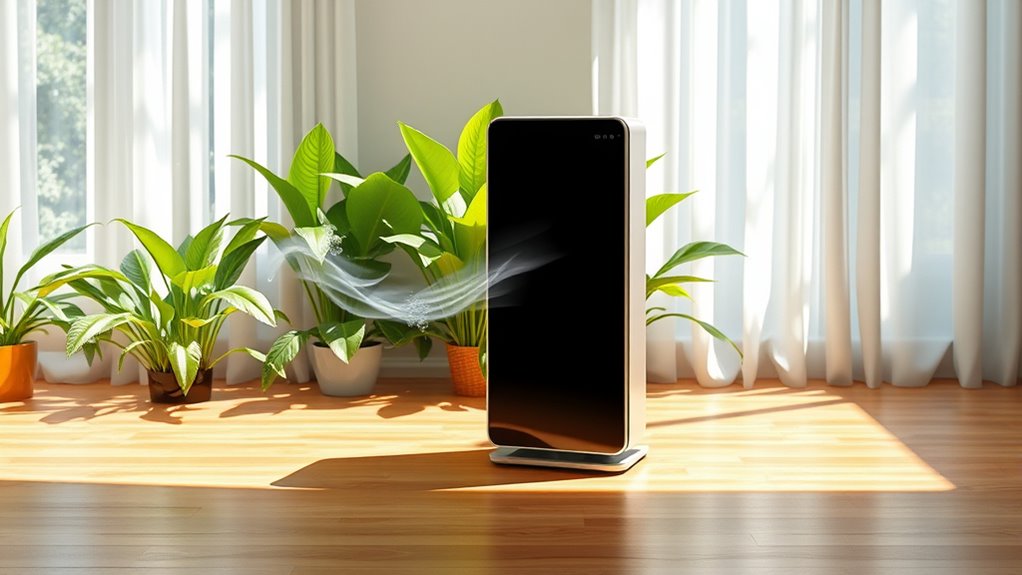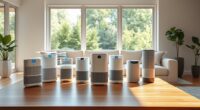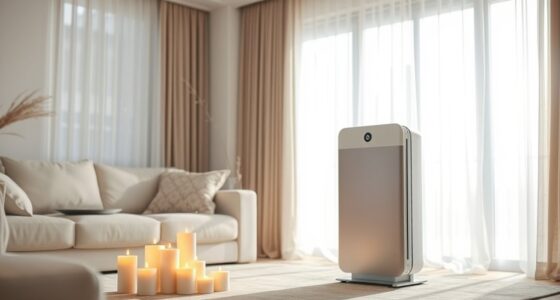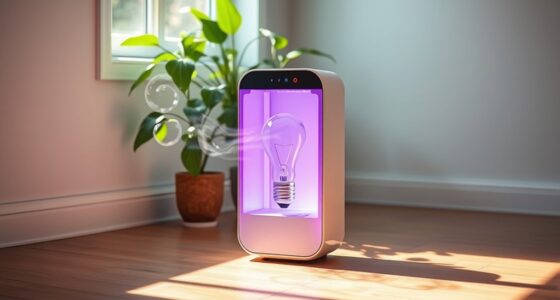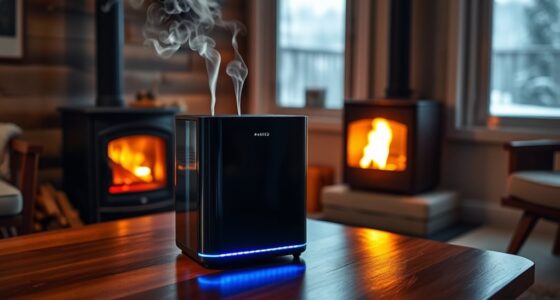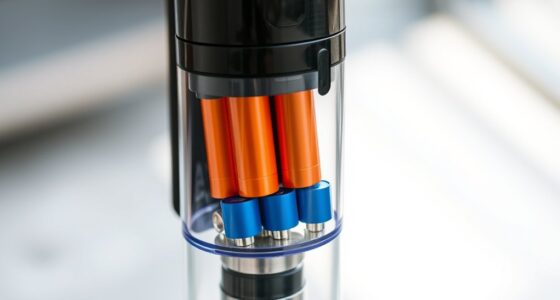Air purifiers play an essential role in reducing airborne bacteria and viruses in your home. They use advanced HEPA filters that capture 99.97% of harmful particles, improving indoor air quality and lowering the risk of respiratory illnesses. Proper placement and maintenance are key for maximum effectiveness. While air purifiers help, they don’t replace basic hygiene practices. If you want to discover more about how to optimize your space for cleaner air, keep going.
Key Takeaways
- Air purifiers with HEPA filters can capture 99.97% of airborne pollutants, including bacteria and viruses, improving indoor air quality.
- Effective air purifiers utilize fans to circulate air, ensuring clean air distribution throughout the space and reducing airborne pathogens.
- Regular maintenance, including filter replacement, enhances air purifier efficiency, allowing for optimal filtration of airborne bacteria and viruses.
- While air purifiers filter air, they do not eliminate viruses on surfaces, so basic hygiene practices remain essential for infection control.
- Introducing fresh air through open windows and doors complements air purifiers by diluting airborne contaminants and lowering overall pathogen concentration.
Understanding Airborne Illnesses and Their Transmission

When you breathe, cough, or sneeze, microscopic droplets can release into the air, potentially carrying airborne illnesses. These pathogens can linger in the air and be inhaled by others, especially in crowded or poorly ventilated spaces. Transmission occurs through droplet transmission during close contact or aerosol transmission with smaller droplets remaining suspended for longer. Common airborne illnesses like COVID-19, influenza, and RSV are particularly prevalent in colder months when people gather indoors. To combat this risk, effective air filtration systems, such as HEPA filters, can greatly reduce airborne pathogens. By improving air quality, you lower the chances of spreading infections, protecting yourself and those around you from these harmful illnesses. Additionally, utilizing air purifiers with smart technology can enhance indoor air quality monitoring, allowing for proactive measures against airborne threats. Regular filter replacement is also crucial for maintaining the effectiveness of these systems and ensuring optimal air purification. Furthermore, using air purifiers that employ UV-C Light Technology can provide an additional layer of protection by eliminating harmful microorganisms. Ensuring proper airflow around the unit enhances the performance of air purifiers, maximizing their ability to reduce airborne pathogens effectively. It is essential to recognize that indoor air quality can be up to 5 times worse than outdoor air, making air purifiers vital in the fight against airborne illnesses.
The Importance of Indoor Air Quality
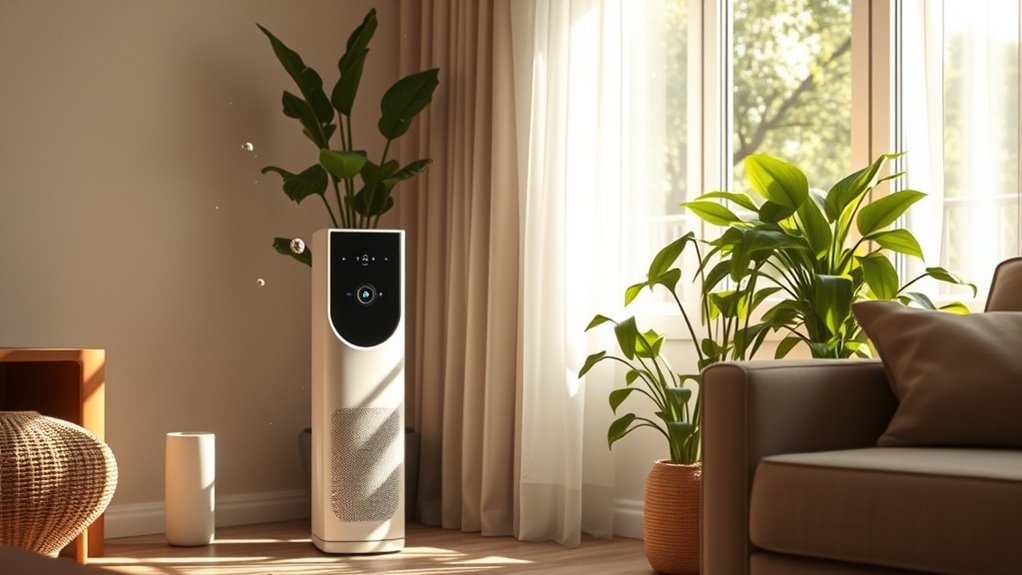
Indoor air quality plays an essential role in your overall health, as poor air can lead to respiratory issues and make you more susceptible to airborne illnesses. Studies show that indoor air can be 2 to 5 times more polluted than outdoor air, often due to dust, pet dander, and volatile organic compounds. This pollution is serious; the World Health Organization estimates that household air pollution contributes to 4.3 million deaths annually. By improving your air quality, you can reduce exposure to harmful pollutants, including airborne bacteria and viruses. Regularly using air purifiers can greatly lower airborne pathogens in your home, creating a healthier living space. Additionally, many air purifiers are designed to be user-friendly and effective, making it easier for homeowners to maintain a clean indoor environment. HEPA filters are particularly effective in capturing these airborne pathogens. A variety of cold medications can also help alleviate symptoms related to respiratory infections, similar to how clean air enhances your health. High contrast ratios in projectors can enhance the viewing experience in your home cinema, similar to how clean air enhances your health. Consistent maintenance of air purifiers is essential for optimal performance. Prioritizing indoor air quality is vital for safeguarding your health and well-being.
How Air Purifiers Work to Improve Air Quality
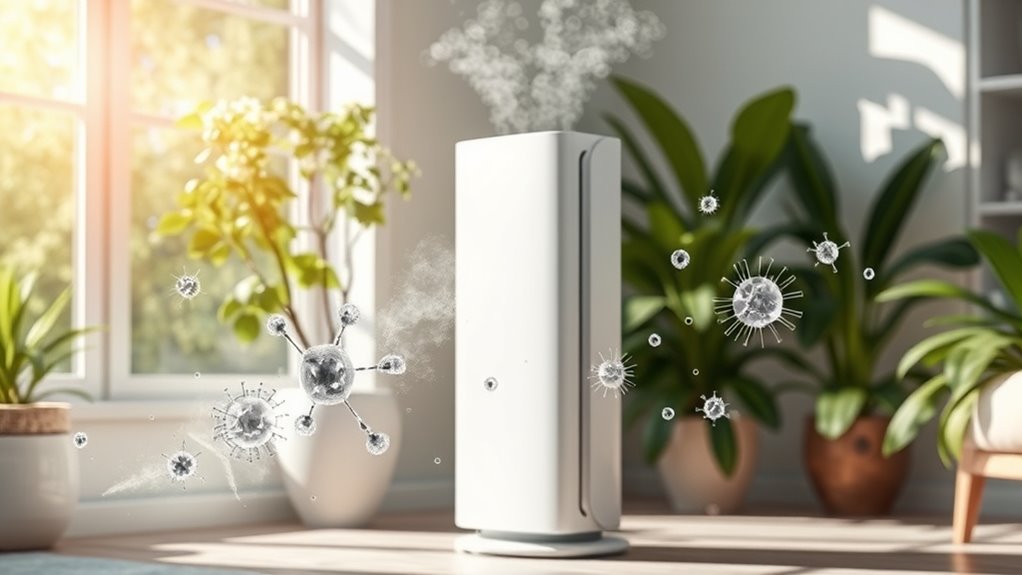
Air purifiers improve air quality through effective filtration mechanisms and optimized airflow.
When you turn on an air purifier, it uses fans to pull in air, which then passes through filters that capture harmful particles like bacteria and viruses. Understanding how these systems work can help you choose the right purifier for your home. Additionally, many air purifiers utilize advanced filtration technology to enhance their effectiveness against airborne contaminants. For example, models like the True HEPA filter can capture 99.97% of airborne pollutants. To maximize efficiency, it is also important to consider seasonal energy efficiency ratings when selecting an air purifier, as they can indicate the energy consumption of the unit. Furthermore, maintaining proper insulation in your home can complement air purification efforts by minimizing the entry of outdoor pollutants. Regular cleaning with robot vacuum cleaners can also help reduce the amount of dust and allergens in your home environment.
Filtration Mechanisms Explained
Filtration mechanisms play an essential role in how air purifiers enhance air quality by removing harmful particles from your environment.
Air purifiers use fans to draw in contaminated air, which passes through various filters, including the HEPA filter. This filter captures at least 99.5% of particles as small as 3 microns, effectively trapping many airborne pathogens, similar to how BPD benefits from psychotherapy in managing emotional instability. Understanding the importance of air quality is crucial for maintaining a healthy living environment. Regular maintenance practices, such as preventive care, can further enhance the efficiency of air purifiers. Additionally, the use of wood pellet fireplaces can contribute to improved indoor air quality by providing a cleaner burning option for heating.
Some models also feature activated carbon filters for gases and UV light for additional sterilization, improving their air purification capabilities.
The Clean Air Delivery Rate (CADR) is key in determining how quickly an air purifier can filter air in your space.
To maintain ideal performance, remember that regular maintenance and timely filter replacement are vital, as clogged filters can hinder the purification process. Additionally, regular filter cleaning is crucial for optimizing the air purifier’s efficiency and prolonging its lifespan.
Importance of Airflow
While you mightn’t realize it, the placement and airflow of your air purifier are vital for maximizing its effectiveness.
Air purifiers use fans to draw in room air and pass it through air filters, like HEPA filters, which trap at least 99.5% of particles, including bacteria and viruses.
The Clean Air Delivery Rate (CADR) indicates how well your purifier improves indoor air quality, so it’s important to position it correctly.
By ensuring ideal airflow, you help distribute clean air throughout the entire space, reducing the concentration of airborne pathogens.
Continuous use of your air purifier not only keeps your environment air clean but also lowers the risk of infections, making proper placement a key factor in your health. Additionally, predictive analytics can help in monitoring air quality trends and optimizing purifier settings for maximum efficiency.
HEPA Filters: Effectiveness in Capturing Pathogens
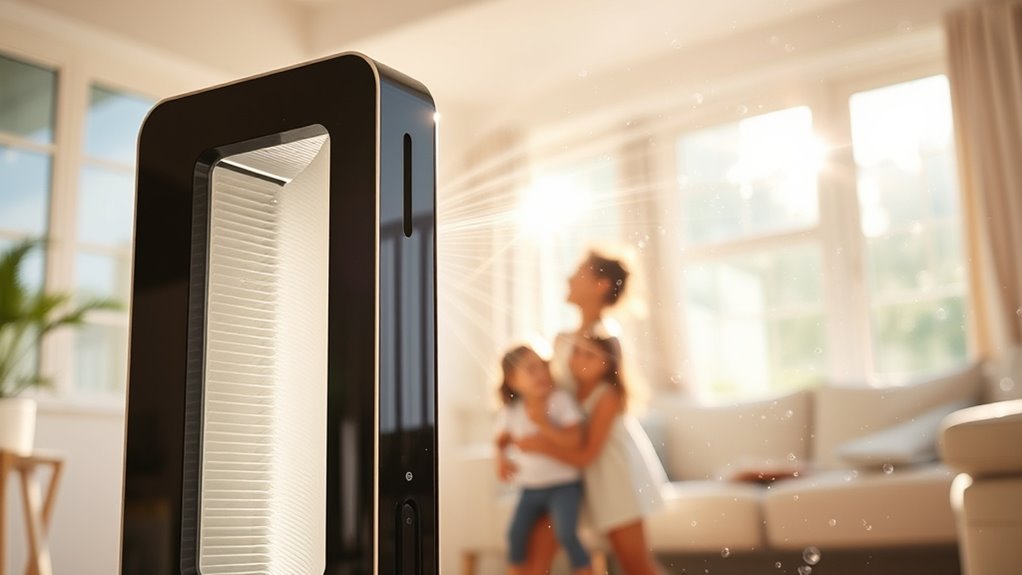
When it comes to air purification, HEPA filters stand out for their ability to capture at least 99.995% of particles as small as 0.3 microns, including viruses and bacteria.
Even though many viruses are smaller than this size, HEPA filters can still effectively trap them through various filtration mechanisms.
This efficiency makes them an essential component in reducing airborne pathogens and improving indoor air quality.
HEPA Filter Efficiency
Understanding the efficiency of HEPA filters is essential for anyone concerned about indoor air quality, especially regarding airborne pathogens.
These filters capture at least 99.995% of particles down to 0.3 microns, making them significant in trapping airborne bacteria and viruses.
Here’s what you should know:
- They effectively filter smaller particles, including those expelled during coughing or sneezing.
- HEPA filters trap viruses, preventing them from recirculating and being inhaled.
- Regular maintenance and replacement are important; clogged filters can reduce airflow and efficiency.
Virus Particle Size
HEPA filters play an essential role in capturing airborne pathogens, but their effectiveness hinges on the size of virus particles. While most viruses, including coronaviruses, range from 0.1 to 0.3 microns, HEPA filters can still capture these smaller particulates.
They achieve this through mechanisms like interception and diffusion, which allow them to trap particles effectively. Research shows that HEPA filters can reduce airborne viruses by up to 99% in controlled environments, considerably lowering the risk of transmission.
Although these filters don’t kill viruses, they do trap them on the surface, preventing further spread when maintained properly. Choosing the right air purifier is vital, as airflow rate and space size also impact the filter’s effectiveness against bacteria and viruses.
Limitations of Air Purifiers in Infection Control
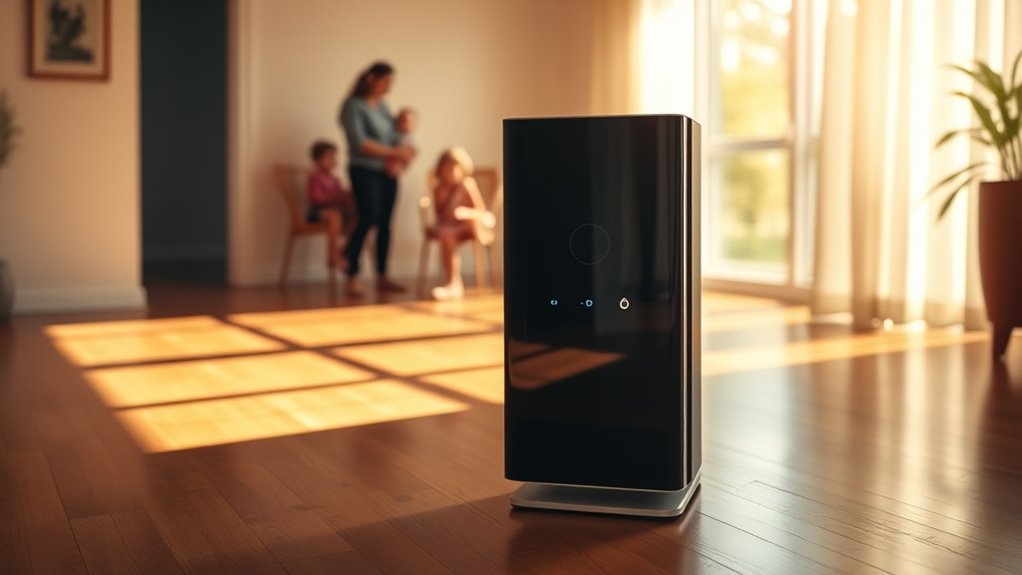
Although air purifiers can considerably reduce airborne particles, they’ve notable limitations in infection control. They primarily filter the air but don’t kill viruses, leaving some viable on the filter for hours or days.
Here are three key limitations to take into account:
- Size Matters: Many viruses, like coronaviruses, are smaller than the particles HEPA filters capture, meaning complete elimination isn’t guaranteed.
- Surface Settling: Air purifiers only clean the air in their immediate vicinity, so virus-laden droplets on surfaces remain unfiltered and can pose risks.
- Hygiene Essentials: Basic hygiene practices, such as disinfecting surfaces and handwashing, are vital and can’t be replaced by air purifiers alone in combating air pollution and infection spread.
The Role of Fresh Air and Natural Ventilation
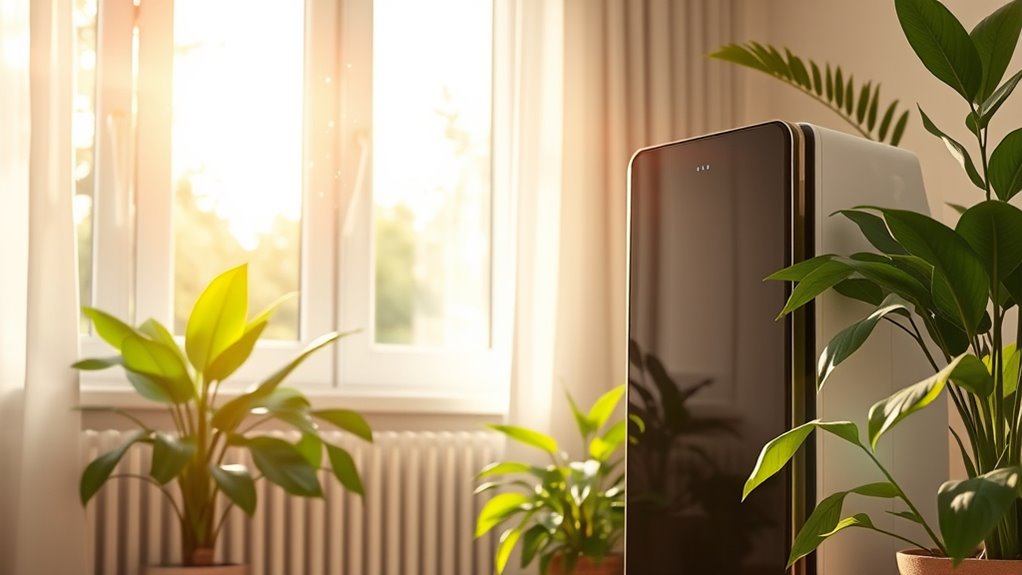
Fresh air and natural ventilation play a crucial role in keeping indoor air quality high.
By opening windows and doors, you can boost air circulation and reduce airborne contaminants, which is especially important in crowded spaces.
When you combine this fresh air with air purifiers, you create a healthier environment that minimizes the risk of airborne diseases.
Importance of Air Circulation
Effective air circulation is essential for maintaining healthy indoor environments, as it helps dilute pollutants and lowers the concentration of airborne bacteria and viruses.
By ensuring fresh air flows into your space, you can greatly improve indoor air quality. Here’s how you can enhance air circulation:
- Open windows to invite fresh outdoor air and replace stale indoor air.
- Use fans to distribute air evenly throughout the room, preventing hotspots of stagnant air.
- Install ventilation systems that continuously refresh indoor air, effectively reducing airborne pathogens.
Benefits of Open Windows
When you open your windows, you invite a rush of natural ventilation that greatly enhances indoor air quality. This fresh air circulation dilutes airborne bacteria and viruses, markedly lowering your risk of infection.
Studies show that proper ventilation can reduce the concentration of airborne pathogens, making your living space safer. By letting in clean air, you also decrease carbon dioxide and other pollutants, which improves your overall health.
Additionally, natural ventilation helps maintain humidity levels, making it harder for viruses to thrive. Regularly revitalizing your indoor air by opening windows for just a few minutes each hour can effectively lower airborne viral loads, contributing to a healthier environment for you and your family.
Combining Ventilation With Purifiers
While relying solely on air purifiers can improve indoor air quality, combining them with natural ventilation takes your efforts to the next level.
By opening windows and allowing fresh air in, you can enhance the effectiveness of air purifiers. Here’s how:
- Fresh Air Circulation: Natural ventilation dilutes airborne pathogens, allowing air purifiers to filter out contaminants more efficiently.
- Humidity Control: Effective ventilation strategies reduce indoor humidity levels, making it tougher for bacteria and mold to thrive.
- Virus Reduction: Well-ventilated spaces greatly lower airborne virus concentrations, complementing the filtration capabilities of air purifiers.
Incorporating both air purifiers and fresh air sources creates a healthier indoor environment, especially important when windows are often closed during cold months.
Best Practices for Using Air Purifiers

To get the most out of your air purifier, it’s essential to follow some best practices that enhance its ability to reduce airborne bacteria and viruses.
First, make sure your air purifier is equipped with HEPA filters, which capture 99.995% of particles as small as 0.3 microns.
Position your air purifier in high-traffic areas and near sources of contaminants to optimize air circulation.
Regularly replace or clean the filters as per the manufacturer’s guidelines to maintain performance.
Keep doors and windows closed while the purifier operates to minimize unfiltered air.
If you’re dealing with larger spaces, consider using multiple air purifiers or selecting units with a higher Clean Air Delivery Rate (CADR) for extensive coverage.
Complementary Hygiene Measures to Prevent Illness

Air purifiers play an essential role in improving indoor air quality, but they’re most effective when combined with other hygiene measures.
By implementing these practices, you can help prevent the spread of airborne bacteria and viruses:
- Wash your hands regularly with soap and water for at least 20 seconds to eliminate pathogens that can transfer to your face or surfaces.
- Disinfect frequently-touched surfaces, like doorknobs and light switches, to greatly reduce microbial load in your environment.
- Cough or sneeze into your elbow to contain respiratory droplets and limit the release of viruses into the air.
While air purifiers can reduce airborne pathogens, adopting these hygiene measures enhances your overall defense against illness.
Case Studies on Air Purifiers in Healthcare Settings
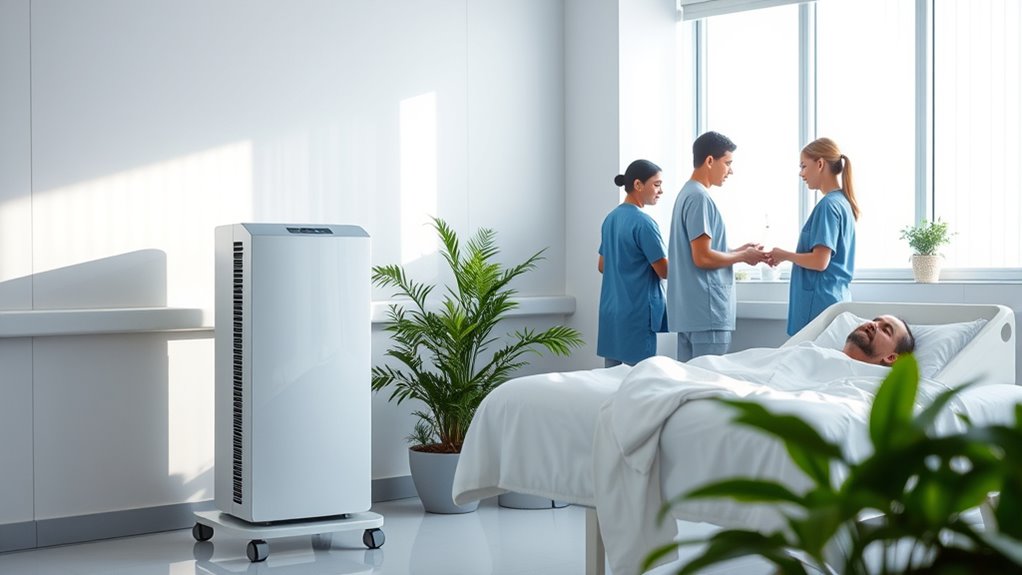
As healthcare facilities face increasing challenges in controlling infections, case studies demonstrate the effectiveness of air purifiers in enhancing patient safety. In a study within two intensive care units (ICUs), the introduction of Novaerus air purifiers led to a marked reduction in microbial load, resulting in decreased rates of hospital-acquired infections. After two months, the intervention ICU reported a considerable drop in colony counts, with a P-value of less than 0.001. This suggests that air purifiers can effectively lower the risk of infections from an infected person by diminishing airborne and surface microbial presence.
| Metric | Intervention ICU |
|---|---|
| Initial Colony Count | High |
| Final Colony Count | Considerably Lower |
| P-Value | < 0.001 |
| Infection Rate | Reduced |
| Correlation with Load | r=0.406, P=0.049 |
Choosing the Right Air Purifier for Your Needs
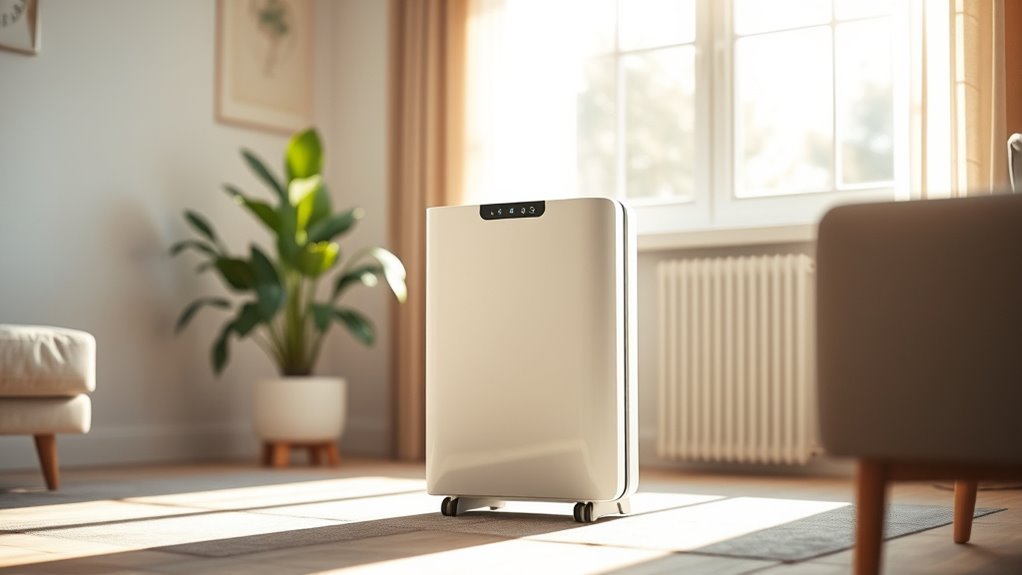
Choosing the right air purifier can considerably impact your indoor air quality, especially if you’re concerned about airborne bacteria and viruses.
To make the best choice, consider these key factors:
- HEPA Filters: Look for an air purifier with HEPA filters that capture at least 99.5% of particles down to 3 microns, including bacteria and viruses.
- Clean Air Delivery Rate (CADR): Check the CADR rating; higher ratings mean more effective cleaning for specific pollutants.
- Room Size: Verify the air purifier is suitable for your room’s square footage for peak performance.
Additionally, evaluate features like activated carbon filters for odors and confirm maintenance is easy with accessible replacement filters.
This way, your air purifier remains effective over time.
Frequently Asked Questions
Do Air Purifiers Help With Bacteria and Viruses?
Yes, air purifiers can help with bacteria and viruses.
They use advanced filters, like HEPA, to capture up to 99.995% of airborne particles, including those tiny pathogens. By reducing their concentration in your indoor air, you lower the risk of transmission.
However, remember that while air purifiers trap these particles, they don’t kill them, so you still need to maintain good hygiene practices to guarantee a healthy environment.
Do Air Purifiers Reduce Viral Load?
Imagine you’re in a crowded office during flu season. You might wonder if an air purifier could help.
Yes, air purifiers can reduce viral load by filtering out tiny droplets that carry viruses. For instance, if you place a HEPA-equipped air purifier in that office, it can considerably lower the number of airborne viruses, creating a healthier environment.
Just remember, while they’re effective, combining them with good hygiene practices is essential too.
What Is the Main Purpose of Air Purifier?
The main purpose of an air purifier is to improve your indoor air quality.
It filters out airborne contaminants like dust, pollen, and pet dander, making it easier for you to breathe.
By trapping these particles, you’ll notice fewer allergens in your home, leading to a more comfortable and healthier environment.
Regular use of an air purifier can also help reduce odors, creating a fresher atmosphere for you and your family.
Does an Air Purifier Help Prevent Sickness?
Imagine walking into a room filled with fresh, crisp air, where your lungs feel lighter.
An air purifier can help create that environment, reducing airborne particles that may contribute to illness. While it can’t eliminate all germs, it considerably lowers harmful pollutants and enhances air quality.
So yes, using an air purifier can help you feel healthier and potentially prevent sickness, especially when combined with good hygiene practices.
Your well-being deserves that boost!
Conclusion
In a world where airborne threats lurk like unseen shadows, air purifiers can be your trusted allies in the fight for cleaner air. By reducing harmful bacteria and viruses, they play a crucial role in maintaining a healthy indoor environment. However, remember that they’re just one piece of the puzzle. Pairing them with good hygiene practices will create a fortress against illness, ensuring you breathe easier and live healthier. So, embrace the power of pure air!
